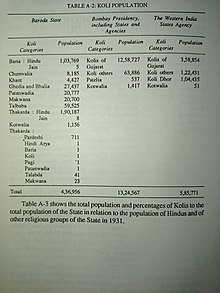Talpada Kolis
| Talpada Koli તળપદા કોળી | |
|---|---|
| Sub-caste of the Koli caste | |
 Koli population in Gujarat in 1931 including Talpada Kolis | |
| Ethnicity | Koli people |
| Location | |
| Varna | |
| Parent tribe | Kolis of Gujarat |
| Population | 59,525 (1931) |
| Demonym(s) | |
| Branches |
|
| Language |
|
| Religion | |
| Surnames | |
The Talapada Koli,[1] or Talpada Koli,[2] is a subcaste of the Koli caste of Gujarat state in India.[3] Talapada Kolis are agriculturists by profession.[4] they were members of the Gujarat Kshatriya Sabha, an organisation launched by Natwarsinh Solanki who was a Koli elite.[5] In 1907, they were classified by the British as a Criminal Tribe, ascribing to them a range of anti-social activities such as highway robbery, murder, and theft of animals, cattle and standing crops. They were also alleged to be blackmailers and hired assassins.[6]
The Talpada Kolis used the title of Kotwal because of their high position villages and served to rulers as Kotwal and they were granted the villages or large field and title of Pagi because they were good detective for rulers or any chief.[7] Another title of Talapada Kolis is Patel because they are agriculturists and respected cultivators from old days.[8]
Origin
[edit]The Talapada Kolis got their name from Talpad region in Junagadh State of Gujarat which they ruled.[5] Talapada Kolis means indigenous Koli used in 19th century.[9] They speak Gujarati language of Gujarat.[10] The Talapada Kolis found in South, Central as well as Peninsular Gujarat.[11]
History
[edit]In an unpublished paper on Talpada Kolis in south Gujarat, Arjun Patel mentions that a number of Talpada Kolis had participated in the 1926 non-cooperation movement, in the 1930 Dandi Satyagraha, and the Quit-India movement of 1942. From the Olpad and Choryasi talukas alone 91 Kolis became freedom fighters. Koli leaders here have been active in bringing about social reforms among their folk. Twenty-three caste associations (gnati sangathano) have been recorded in south Gujarat by Patel. The main objectives of these associations are social reform, promotion of education, and furtherance of the economic interests of Kolis. These associations, like the north Gujarat Koli associations, do not avowedly profess any political objective. Patel (1992) notes that many associations in south Gujarat held joint activities. However, the efforts of the south Gujarat Kolis to unite with Kolis of other regions were unsuccessful.[11]
Kambad, a Talpada Koli from Bhavnagar, Saurashtra, in his book (1981:453, in Gujarati), Samast Koli Samaj (All Koli Association), writes that since 1951 meetings were held nearly every year at different places in Saurashtra to bring about a fellow feeling among Kolis and to promote all-round development among them. According to Roy (1983), this association took formal shape on 20 November 1973, under the title Samast Talpada Koli Samaj (All Talpada Koli Society). Its first convention was held at Chotila (Surendranagar district) where about 7000 Kolis from Saurashtra assembled. During this convention the bandharan (constitution) of the association was framed and approved.[11]
Clans
[edit]Here are main clans found in Talapada Kolis:[3][5]
Titles
[edit]Talapada Kolis have two titles:[3][11]
Organisations
[edit]- 1974, Shri Talapada Koli Patel Samaj, Surat[12]
- 1961, Shri Talapada Koli Gyati, Bhavnagar[13]
- Dakshin Gujarat Koli Patel Samaj Sangh, Surat[11]
- Bardoli Pradesh Taluka Koli Samaj[11]
- Shri Chikhli Taluka Koli Samaj[11]
Classification
[edit]The Talapada Kolis are classified as a Other Backward Class, or OBC caste by Government of Gujarat.[14]
References
[edit]- ^ Patel, Mahendra Lal (1997). Awareness in Weaker Section: Perspective Development and Prospects. New Delhi, India: M.D. Publications Pvt. Ltd. p. 251. ISBN 978-81-7533-029-0.
- ^ "Gujarat: Rs 5 lakh fine for provocative social media messages | Rajkot News - Times of India". The Times of India. TNN. Jan 29, 2021. Retrieved 2022-03-27.
- ^ a b c Shah, A. M. (1998). The Family in India: Critical Essays. New Delhi, India: Orient Blackswan. pp. 126–128. ISBN 978-81-250-1306-8.
- ^ Chahel, Paramjot Singh (2015-10-30). Undisclosed Facts of Tribal Life. New Delhi, India: Partridge Publishing. ISBN 978-1-4828-3834-3.
- ^ a b c Lal, R. B. (2003). Gujarat History. New Delhi, India: Popular Prakashan. pp. 716–721. ISBN 978-81-7991-104-4.
- ^ Yagnik, Achyut (2005-08-24). Shaping Of Modern Gujarat. New Delhi, India: Penguin UK. ISBN 978-81-8475-185-7.
- ^ Shah, A. M. (2002). Exploring India's Rural Past: A Gujarat Village in the Early Nineteenth Century. New Delhi, India, Asia: Oxford University Press. pp. 82–91. ISBN 978-0-19-565732-6.
- ^ Tambs-Lyche, Harald (1996-12-31). Power, Profit, and Poetry: Traditional Society in Kathiawar, Western India. New Delhi, India: Manohar Publishers & Distributors. pp. 131: Tarabda. ISBN 978-81-7304-176-1.
- ^ Shah, A. M. (2012-12-06). The Structure of Indian Society: Then and Now. New Delhi, India: Routledge. p. 168. ISBN 978-1-136-19770-3.
- ^ Abbi, Anvita (1997). Languages of Tribal and Indigenous Peoples of India: The Ethnic Space. New Delhi, India: Motilal Banarsidass Publishers. p. 55. ISBN 978-81-208-1374-8.
- ^ a b c d e f g Lobo, Lancy (1995). The Thakors of North Gujarat: A Caste in the Village and the Region. New Delhi, India: Hindustan Publishing Corporation. pp. 162–170. ISBN 978-81-7075-035-2.
- ^ Shah, Ghanshyam (1997). Social Transformation in India: Essays in Honour of Professor I.P. Desai. New Delhi, India: Rawat Publications. p. 338.
- ^ Shah, Ghanshyam (1975). Caste Association and Political Process in Gujarat: A Study of Gujarat Kshatriya Sabha. New Delhi, India, Asia: Popular Prakashan. p. 204.
- ^ Ahmed, Sara (2005-01-13). Flowing Upstream: Empowering Women Through Water Management Initiatives in India. New Delhi, India: Foundation Books. p. 66. ISBN 978-81-7596-262-0.


 French
French Deutsch
Deutsch